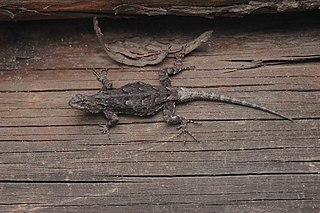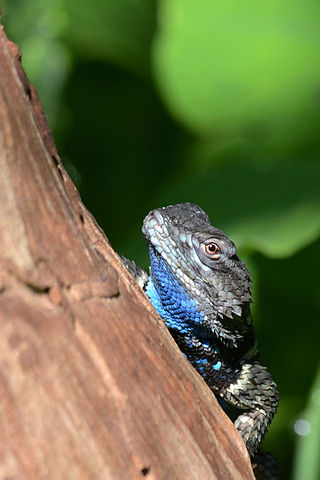
The greater earless lizard is the only species in the monotypic genus Cophosaurus. It is closely related to the smaller, lesser earless lizards and other species in the genus Holbrookia, and in fact was placed in that genus and referred to Holbrookia texana from 1852 into the 1970s. Earless lizards lack external ear openings, an adaptation to burrowing in the sand, as are the recessed lower jaw and flared upper labial scales. Greater earless lizards are sexually dimorphic, males grow larger and are more colorful than females, exhibiting pink and green colors that are particularly bright in the breeding season. Two bold black bars mark the lateral region of males but are greatly reduced and vague, or occasionally entirely absent in females.

Spiny lizards is a common name for the genus Sceloporus in the family Phrynosomatidae. The genus is endemic to North America, with various species ranging from New York, to Washington, and one occurring as far south as northern Panama. The greatest diversity is found in Mexico. This genus includes some of the most commonly seen lizards in the United States. Other common names for lizards in this genus include fence lizards, scaly lizards, bunchgrass lizards, and swifts.

The Mexican blind lizard is a species of legless lizard in the family Dibamidae, and the only species in the genus Anelytropsis. It is endemic to Mexico. They look like Amphisbaenia, but are in fact, only distantly related.

Xenosaurus is a genus of lizards. Xenosaurus is the only extant genus in the family Xenosauridae with 13 species currently recognized. Also known as the Middle American knob-scaled lizards found in southwestern Tamaulipas and eastern Guerrero on the Atlantic and Pacific versants of Mexico, respectively, south and east to Alta Verapaz, Guatemala. They can be found between 300 m and 2360 m of elevation in a wide variety of habitats ranging from xerophytic tropical scrub to cloud forest to tropical rain forest. Where they occupy moderately diverse places, including crevices and holes in limestone, spaces under volcanic boulders, crevices in volcanic rocks, karst limestone, limestone terrain, and hollow logs in dry areas where trees are sparse. A flattened body shape and a crevice-dwelling ecology generally characterize species in the group. In part because of their habitat specialization, all of the known species and subspecies are allopatric, and several have small geographic distributions. Dorsal scales are heteromorphic, not imbrication, and some are conical or developed into enlarged tubercles separated by small granular scales. Ventral scales are flat, quadrate, and arranged in transverse rows. Head scales are generally small, tuberculate, and sometimes conical or rugose, but may be enlarged along the rostra and temporal ridges. Supraoculars also are enlarged, flattened, and in a single longitudinal row. The skin of the neck is loose and expanded, producing at least two angular fold. These lizards are known to feed on a variety of crawling and flying insects. This genus mostly eats orthopterans, coleopterans (beetles), dipterans, and myriapods.
Edward Harrison Taylor was an American herpetologist from Missouri.

Sceloporus poinsettii, the crevice spiny lizard, is a species of small, phrynosomatid lizard.

Sceloporus merriami, commonly known as the canyon lizard, is a species of lizard in the family Phrynosomatidae. The species is native to the south-western United States and northern Mexico.

Sceloporus merriami annulatus, commonly known as the Big Bend canyon lizard, is a subspecies of the canyon lizard, and is endemic to southwestern Texas and adjacent northeastern Mexico.
Hobart Muir Smith, born Frederick William Stouffer, was an American herpetologist. He is credited with describing more than 100 new species of American reptiles and amphibians. In addition, he has been honored by having at least six species named after him, including the southwestern blackhead snake, Smith's earth snake, Smith's arboreal alligator lizard, Hobart's anadia, Hobart Smith's anole, and Smith's rose-bellied lizard. At 100 years of age, Smith continued to be an active and productive herpetologist. Although he published on a wide range of herpetological subjects, his main focus throughout his career was on the amphibians and reptiles of Mexico, including taxonomy, bibliographies, and history. Having published more than 1,600 manuscripts, he surpassed all contemporaries and remains the most published herpetologist of all time.

Ctenosaura acanthura, is a species of iguanid lizard found in eastern Mexico and extreme western Guatemala. The standardized English name is the Mexican spiny-tailed iguana. Confusingly however, an earlier edition of standardized names for Mexican herpetofauna called Ctenosaura acanthura the northeastern spinytailed iguana and applied the name Mexican spinytailed iguana to Ctenosaura pectinata, which was called the western spiny-tailed iguana in the second edition. It has also been referred to as the Veracruz spiny-tailed iguana and Gulf Coast spiny-tailed iguana. It is an egg laying species that is mostly herbivorous and a moderately large lizard commonly growing over one meter in total length.
Michael J. Preston is a professor emeritus of English at the University of Colorado Boulder, specializing in Middle English and early Renaissance literature, vernacular culture, folklore and traditional drama.

Slevin's bunchgrass lizard is a species of lizard in the family Phrynosomatidae. The species is indigenous to the southwestern United States and adjacent northern Mexico.

Sceloporus bicanthalis, the trans volcanic bunchgrass lizard, is a species of lizard in the family Phrynosomatidae, first described by Hobart Muir Smith as a subspecies of Sceloporus aeneus in 1937. It is endemic to Mexico. It was classified by the IUCN as a species with low risk. No subspecies are recognized.

Sceloporus jarrovii, also known commonly as Yarrow's spiny lizard, is a species of lizard in the family Phrynosomatidae. The species is native to the southwestern United States and northern Mexico. There are two recognized subspecies.
Sceloporus chaneyi, the Peña Nevada agave lizard, Chaney's spiny lizard, or Chaney's bunchgrass lizard, is a species of lizard in the family Phrynosomatidae. It is endemic to Mexico.
Sceloporus druckercolini, also known commonly as the graceful mountain tree lizard and lagartija elegante arborícola de montaña in Mexican Spanish, is a species of lizard in the family Phrynosomatidae. The species is endemic to Mexico.

Sceloporus lemosespinali, Lemos-Espinal's spiny lizard, is a species of lizard in the family Phrynosomatidae. It is endemic to Mexico.

Sceloporus samcolemani, also known commonly as Coleman's bunchgrass lizard, Coleman's bunch grass lizard, and lagartija de Coleman in Spanish, is a species of lizard in the family Phrynosomatidae. The species is endemic to Mexico.

Sceloporus torquatus, the crevice swift, is a species of lizard in the family Phrynosomatidae.
Sceloporus huichol is a species of lizard in the family Phrynosomatidae. It is endemic to Mexico, and can specifically be found in the mountainous regions of Jalisco and Nayarit. Sceloporus huichol belongs to the species group torquatus. Phylogenetically, Sceloporus huichol is closely related to Sceloporus melanogaster.














